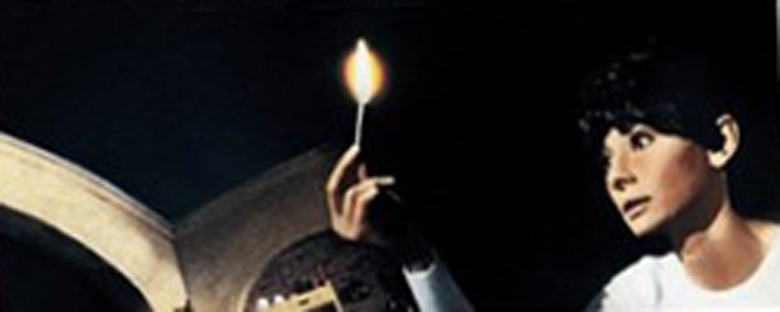Reviews
Terence Young
USA, 1967
Credits
Review by Beth Gilligan
Posted on 08 October 2005
Source Warner Brothers DVD
Related articles
Features: 31 Days of Horror
Years before women-in-jeopardy movies became a staple of the Lifetime channel, Audrey Hepburn scored a critical and box office success playing a blind woman menaced by a group of thugs in Wait Until Dark. While the source material (a Broadway play by Fredrick Knott) never quite transcends this movie-of-the-week feel, director Terence Young does his best to whip up a claustrophobic atmosphere, relying on gimmicky but nonetheless effective techniques such as immersing the screen in total darkness during the film’s climax.
Hepburn’s Susy is a newlywed still struggling to adapt to the blindness that came as the result of a fiery car crash the prior year. She lives with her photographer husband Sam in a small basement apartment in Greenwich Village and relies solely on him and the adolescent girl who lives upstairs for help with errands and other necessities. As played by Hepburn, Susy’s surface vulnerability (which is further exemplified by the actress’ waiflike appearance) belies her spirited nature and inner strength. These latter traits are put to the test when her husband unwittingly carries a doll stuffed with heroin off a plane from Canada.
When Roat, a recently released criminal with ties to the drugs, catches wind of this, he enlists (or rather, blackmails) two small-time crooks to help him reclaim the doll. After sending off Sam on a false photography assignment, the three men begin a cruel game of manipulations to force Susy to divulge the whereabouts of the doll, which has mysteriously disappeared since Sam brought it home.
Assuming a host of false identities, the men barge in and out of the apartment, alternately threatening and cajoling her in hopes she will fess up to the doll’s whereabouts. Susy’s helplessness is underlined during these scenes, as she senses trouble but is unable to discern which of the men she can trust and which she should fear. To add to her insecurity, one of them hints at the possibility of her husband having an affair with the doll’s original owner, a young woman who has since been found murdered.
This general sense of menace builds until Susy finds the doll and uncovers the truth about the men. By this point in the film, Susy’s personal transformation is nearly complete, her tentativeness toward her disability replaced by a steely sense of self-reliance and determination. Frantic with rage and fear, she races around the apartment, smashing every light bulb she can find so that she and Roat will be on equal footing. In a clever marketing ploy, Warner Brothers placed signs outside cinemas notifying audiences that theaters playing the film would be darkened to their legal limit during the movie’s climax so as to heighten the effect of the complete blackness.
Although the movie plays fairly unevenly throughout, largely thanks to the convoluted machinations of the script, Young’s direction takes flight during this sequence. Having directed a handful of the early James Bond films (including Dr. No and From Russia with Love), Young’s strength inevitably lies in generating breathless suspense, and in this instance, his risky decision to have the audience rely on their primal senses pays off. As in some of the most effective horror/suspense films, what you can’t see is much more terrifying than what you can.
We don’t do comments anymore, but you may contact us here or find us on Twitter or Facebook.



